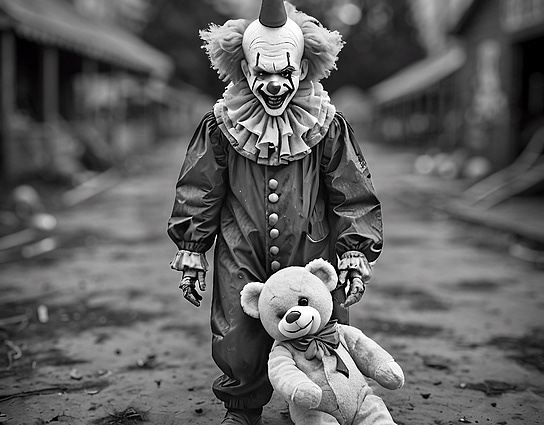Bob Orsillo's photograph, "Clown Dystopia and The Little Teddy Bear," is a haunting and evocative piece that captures a sense of desolation and lost innocence. The black-and-white image features a central figure dressed in a clown costume, walking away from the camera down a dilapidated path. The clown holds a small teddy bear in one hand, adding a poignant and melancholic touch to the scene. The setting appears to be an abandoned amusement park or fairground, with rundown buildings and debris scattered around. The trees are bare, suggesting a cold, possibly wintery atmosphere. The overall composition of the image, with its stark contrasts and haunting subject matter, creates a powerful visual narrative that speaks to themes of abandonment, decay, and lost innocence.
The photograph's black-and-white format enhances its eerie and dystopian feel. The absence of color strips the scene of any warmth or vibrancy, leaving only the stark contrasts between light and shadow. This choice of medium emphasizes the bleakness of the setting and the loneliness of the clown. The dilapidated buildings and barren trees further contribute to the sense of abandonment and decay. The path the clown walks down is cracked and uneven, symbolizing a journey through a broken and desolate world.
The clown, traditionally a symbol of joy and entertainment, is here transformed into a figure of sadness and isolation. The costume, with its exaggerated features and bright patterns, stands in stark contrast to the bleak surroundings. This juxtaposition highlights the incongruity of the clown's presence in such a desolate place. The teddy bear, a symbol of childhood innocence and comfort, adds another layer of poignancy to the image. The fact that the clown is holding the bear suggests a longing for a lost past or a desire to protect something precious in a world that has fallen into ruin.
The setting of the photograph, an abandoned amusement park or fairground, is particularly effective in conveying the themes of the piece. Amusement parks are places of joy and excitement, filled with laughter and the sounds of children playing. In this image, however, the park is empty and decaying, a stark reminder of what has been lost. The rundown buildings and scattered debris suggest that the park has been abandoned for some time, left to fall into disrepair. The bare trees add to the sense of desolation, their skeletal branches reaching out like the fingers of a ghostly hand.
The overall composition of the photograph is carefully crafted to draw the viewer's eye to the central figure of the clown. The path leads the eye towards the clown, who is positioned slightly off-center, creating a sense of movement and direction. The use of light and shadow is also masterful, with the clown's white costume standing out against the darker background. This contrast emphasizes the clown's isolation and the bleakness of the surroundings.
In conclusion, Bob Orsillo's "Clown Dystopia and The Little Teddy Bear" is a powerful and evocative piece that uses stark contrasts and haunting imagery to convey themes of abandonment, decay, and lost innocence. The black-and-white format, the desolate setting, and the poignant symbols of the clown and the teddy bear all work together to create a compelling visual narrative. This photograph is a testament to Orsillo's skill as a photographer and his ability to capture complex emotions and themes in a single image.










